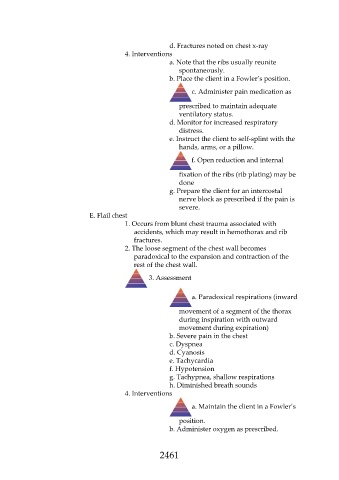Page 2461 - Saunders Comprehensive Review For NCLEX-RN
P. 2461
d. Fractures noted on chest x-ray
4. Interventions
a. Note that the ribs usually reunite
spontaneously.
b. Place the client in a Fowler’s position.
c. Administer pain medication as
prescribed to maintain adequate
ventilatory status.
d. Monitor for increased respiratory
distress.
e. Instruct the client to self-splint with the
hands, arms, or a pillow.
f. Open reduction and internal
fixation of the ribs (rib plating) may be
done
g. Prepare the client for an intercostal
nerve block as prescribed if the pain is
severe.
E. Flail chest
1. Occurs from blunt chest trauma associated with
accidents, which may result in hemothorax and rib
fractures.
2. The loose segment of the chest wall becomes
paradoxical to the expansion and contraction of the
rest of the chest wall.
3. Assessment
a. Paradoxical respirations (inward
movement of a segment of the thorax
during inspiration with outward
movement during expiration)
b. Severe pain in the chest
c. Dyspnea
d. Cyanosis
e. Tachycardia
f. Hypotension
g. Tachypnea, shallow respirations
h. Diminished breath sounds
4. Interventions
a. Maintain the client in a Fowler’s
position.
b. Administer oxygen as prescribed.
2461

